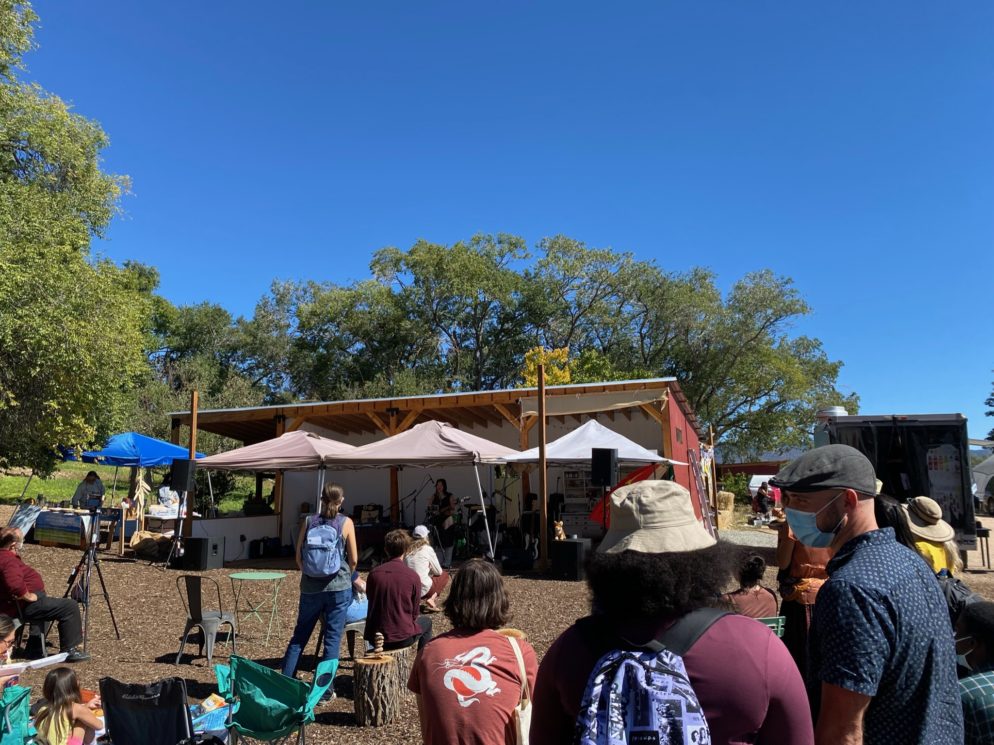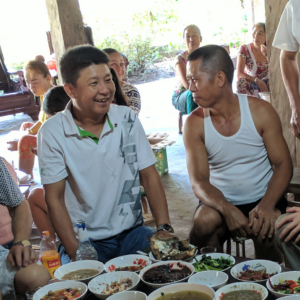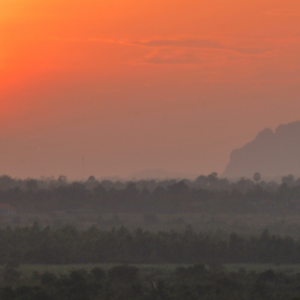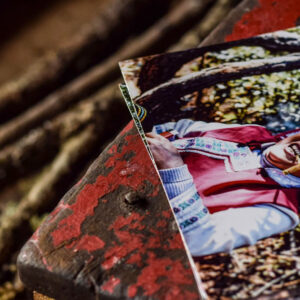Indigenous People’s Day in O’ga P’ogeh: Celebrating Indigenous Futurisms
Posted on
10/21/21
Author
admin
This story is from the field and written by Jacquelyn Kovarik, a Dragons instructor who is currently leading a group of students from Tufts University through a semester in the Southwest (USA). Jac shares her story of the group’s time in New Mexico, celebrating Indigenous Peoples’ Day. Her reflection speaks to the importance of traveling and seeking out lesser known realities in the United States.
Monday, October 11th, 2021 was an eventful day for the Southwest Tufts Civics Semester. It was our last day in northern New Mexico, which had been our program base for the first half of the semester. It was also Indigenous Peoples Day 2021, and the first year this day had been federally recognized by the so-called United States. As we began to say our goodbyes to the dramatic and recently snow-capped Tewa Kusempi peaks (the so-called Truchas Peaks), it felt fitting to head to a Tewa-led community celebration of Indigenous excellence in O’ga P’ogeh (so-called Santa Fe). We spent all day Sunday cleaning and packing so we could pile into the van and Jeep on Monday morning to head an hour south for the celebration.
“Indigenous Peoples Day: Back to Our Roots – Celebrating Indigenous Excellence” was a community celebration put on by the Three Sisters Collective (3SC), a collective of Pueblo, Tewa, Diné, and other native women. Dr. Christine Castro, who also goes by “Dr. X”, is a founding member of the collective and first let us know about the celebration five weeks prior, when we met with her in so-called Santa Fe during our orientation week for a native-centered tour of the city. Dr. X is a tribal member of two Tewa Pueblos and has dedicated her life to educating her communities and the greater Santa Fe community about Tewa culture and the ongoing fight against neo-colonization and neo-colonialism. Seeing Dr. X that Monday afternoon, completely in her element and often being trailed by laughing native children, was so joyous—she was surrounded by her community of native and non-native friends and loved ones, and the day’s activities were dedicated to celebrating Indigenous excellence. This was radical joy in the face of colonization and violence. It was tangible and so so sweet.
The celebration was hosted by Reunity Resources, a farm and community center in Agua Fría, Santa Fe. This was not our first time at Reunity—we had come first with Dr. X on that Sunday five weeks prior and had also returned in mid-September for their Fall Festival. Returning again for Indigenous Peoples Day really felt like we had become a part of the northern New Mexico community in a meaningful way, despite five weeks having flown by. The sun was shining and native vendors were selling their art and work in rows along the rows of corn and wildflowers. Solange Aguilar, a queer Apache/Yo’eme/Kalnga/Kapampangan artist, sold us stickers that said “My Queerness is Ancestral” and “Protect the Land with Me.” Students bought jewelry and handicrafts for their friends and loved ones back home. Sticky sweet paletas dripped down our forearms as we gathered in the performance space to listen to the Indigenous open mic. Everything felt so abundant, immediate, vital.
Celebrating Indigenous Futurisms
The performances started off with a young native Japanese girl named Ishi. Her voice was breathtakingly beautiful and carried over the vendors and blooming crops: You cannot eat money, when the rivers are poisoned and the fields are barren you cannot eat money. What if we lived in a world that valued the earth and sustenance over monetary gain and capitalism? These are Indigenous futurisms and Ishi was generously giving us a taste.
Israel F. Haros Lopez was sitting nearby, beside his pregnant spouse. About a month prior we had gathered on this same farm with Israel to make art and commune with the earth. Israel is the founder and director of Alas de Agua, a grassroots art collective in so-called Santa Fe run by and for Chicanx, Latinx, Indigenous, queer/trans, immigrant, and BIPOC artists. I was surprised to see that Israel’s spouse had not yet given birth – when we met with him nearly a month prior he had said the baby was coming any day now. “Alas de Agua” translates to “Wings of Water” in English. Israel jumped up and walked to the open mic, a water glass in hand. He grabbed the mic: “Together we are going to call forth the names of our baby – multiple names because we have not decided on one yet. He is overdue and we so badly want him here with us.” His voice cracked and there were tears in his eyes, and he looked directly at his spouse and began to perform spoken word, calling on Water to deliver their baby. Water is our blood. Water is our bodies. The water we shared the first time we made love. The water that is holding our son now. The water that is our love. Water is our baby. Water is life. Let the Water break now. Israel was calling on Water to deliver their baby, sharing the glass of water with his spouse at the end. What if we lived in a world that valued water as our teacher, our lover, our elder? What if we lived in a world that revered water as a sentient being with personhood and rights? These are Indigenous futurisms and Israel was generously giving us a taste.
To the left of the stage were a group of people sitting in a circle and harvesting amaranth seed as they listened to the performances. Two people stood up, brushed the amaranth seeds off their laps, and headed to the mic – Beata Tsosie-Peña and Frayer of Tewa Women United. TWU is a collective based in Española that works to build the Tewa community and end violence against Indigenous women, girls, and Mother Earth. We had met Beata and Frayer a few weeks prior in Española, when we met with them for an afternoon at the Española Healing Gardens Oasis and learned about the intersections between seed sovereignty, Indigenous sovereignty, and reproductive/gender justice. In addition to working as the Environmental Health and Justice Coordinator at TWU, Beata also works as a doula and is a Pueblo representative for the New Mexico Governor’s task force on Missing and Murdered Indigenous Women. That day we harvested beautiful purple and pink colored beans in the field, laughing with our hands in the dirt. Beata and Frayer took the mic for a spoken word duet: The elm tree did not ask to be planted along our Río Bravo shores. They were brought over without their consent, by white men who knew nothing about their seeds, their branches, their root systems. What if we lived in a world that treated seeds and plants as our elders? What would it mean to ask a plant for consent, to form a loving relationship with the ecologies around us? And what if we lived in a world where native women could give birth the way they wanted, and lived without fear of violence? These are Indigenous futurisms and Beata and Frayer were generously giving us a taste.
As the open mic came to a close, a DJ started mixing The Bee Gees and a dance party broke out. We hopped and stomped and spun around in the late afternoon sun with everyone else who had just witnessed all the beautiful wisdom of the Indigenous open mic, and as we moved our bodies there was an undeniable wave of irresistible joy.
The site and organizational visits we have been doing on this program are often heavy. From nuclear colonialism and the effect of Los Alamos and the Trinity Test Site atomic bomb testing on the immediate surrounding Indigenous communities and on the whole planet; to environmental racism and the incarceration of Black and Brown youth in underserved Albuquerque neighborhoods; to the struggles of immigrants to obtain legal protections in our country’s broken immigration system; to the violence that trans, non-binary and femmes migrants face while trying to cross the border for a better life – liberation for all often feels far from our current reality. Beata herself shared with us that the reason she got involved in environmental health and justice work was due to the daily realities of living next to a nuclear weapons complex. There is much healing to be done.
The celebration at Reunity Resources this Indigenous Peoples’ Day was a reminder of the power of radical hope and joy—the need for this in the healing process. Despite ongoing colonization and violence, we danced. We danced together, and together we witnessed —with our own eyes and ears and bodies—what Indigenous futurisms hold, for us all, if we are willing to listen and learn.
Hear what students had to say about the celebration
Lily Feng, 18, Farmington, Connecticut: “There was a moment where we were in the courtyard listening to the open mic, and I looked around and saw all the diversity of people there, and it struck me that we were taking part in something revolutionary. It was the first time Indigenous People’s Day had been recognized by the Biden administration, and it was the first time the Three Sisters Collective had put on this celebration, and it felt powerful. It also felt like our first portion of the trip had come full circle – all the Indigenous people who we had met while in northern New Mexico were there, and it felt like we had created longterm and meaningful relationships. We were able to participate in these radical Indigenous futurisms, as Dr. X said, and that is powerful.”
Caroline Bewley, 18, Willamette, Illinois: “What made this day particularly memorable was that it was our last day in northern New Mexico so it was a day that was already filled with so much emotion. We got to go for an Indigenous People’s Day celebration at the farm that we went to on our first day, so going back really was a full circle moment and felt like the perfect way to end this chapter of the program. We also got to listen to spoken word poetry, music, and singing from Indigenous creatives which I really enjoyed. Additionally, at the celebration we got to say goodbye to some of the people that had taken the time to meet with us and teach us more about what they do and how they are contributing to the betterment of their communities.”
Biani Ebie, 18, Lagos, Nigeria and Boston, Massachusetts: “I really enjoyed the celebration. Just being able to witness Indigenous excellence was something special. Seeing Dr. X and Israel and Beata and Frayer again, it felt like a full circle moment and felt like the best way to end our time in northern New Mexico. It felt cyclical in the best way possible.”
Ben Chisam, 18, Atlanta, Georgia: “It was really powerful because Dr. X shared about how the particular Indigenous community that was coming together for the day’s celebration was a new community. It was powerful to see that space being created. We witnessed a lot of the colonialism of Santa Fe as a city during our time in northern New Mexico, and it felt powerful to see a decolonial space created by Indigenous people and for Indigenous people. It was also a testament to the fact that Indigenous people are not just a figment of the past, but are very much a force of the present and will be in the future as well. It was a safe and radically inclusive space to be in.”
Learn more about our domestic Summer Programs and Gap Year Semesters for the 2022 season. The program most closely related to this story is the Rio Grande Semester, offered next in Fall 2022.









Leave a Comment